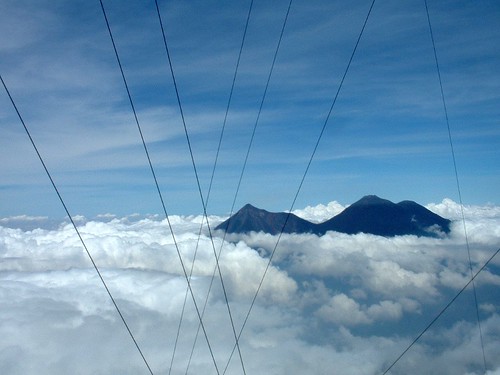
Perhaps they betray the lack of creativity of the Spanish conquerors who generally used the crutch of saints' names for their prosaic place-names; or perhaps there is simple poetic grace in their straightforward names. In any case, the volcano near Antigua that used to have a lake in its crater is called Agua (water), and the one that is still actively spewing lava is called Fuego (fire). Pretty clever. While Fuego gets all the attention when it occasionally showers Guatemala with ash, it is the now-waterless Agua that dominates the view from Antigua, and to a lesser extent, from Guatemala City.
(The water in the former crater lake atop Agua rushed out in the last eruption, hundreds of years ago, and destroyed the first Spanish capital, now known as Ciudad Vieja (Old City). This prompted them to move the capital a few miles over to Antigua, which was leveled by an earthquake practically the next day, so they moved the capital another twenty miles to what is now Guatemala City. Guatemala City has since been more-or-less leveled by subsequent earthquakes, but they'd apparently grown weary of moving the capital down the road a spell by the time that happened. "Ciudad Antigua" means "Ancient City," even though the merely "Old City" is actually older. It's a country filled with mysteries.)
Having taken enough taunting from its looming presence, I climbed Agua yesterday. (The photography department has informed us that our cliché-averse staff photographer is the only person to ever go to Antigua and not come back with a picture of Agua towering over the quaint colonial architecture. He has been put under the lash. For now, here's a picture from some other random guy.) Your correspondent was accompanied by five of the other fine gentlemen who represent the United States in this fair country, including one American Diplomatic Security guy and accompanied by a Guatemalan National Police officer who is assigned to the Embassy beat, each of these two "packing heat" but inexplicably unwilling to shoot their guns off into the sky at 12,336 feet. Maybe due to the effects of altitude, the DS agent forgot we were in Guatemala. I don't know what the Guatemalan's excuse was.
The climb was not actually that painful, in part because your correspondent's SUV-owning colleagues were able to drive us much further up the mountain than any of us had anticipated. As such it was only a three-hour climb, on a well-beaten, switch-backing trail. The views from the top were predictably amazing. What had started as a clear day wound up fairly cloudy, but we had climbed above it. Only a few other nearby volcanoes peaked out above the clouds (Fuego included, pictured above with its more traditionally-named twin, Acatenango). While the views of the cloudtops and mountaintops were magnificent, the predominant feature of the summit was antennae, antennae, and more antennae. Between radio, tv, and cell-phone towers, the many small shacks built at their bases, and the many cables and guywires holding the towers up, the top of the mighty volcano turned out to be less solitary than one might think. The technology still provided some interesting contrasts, and only partially obstructed the fine views, which we enjoyed with sips from the one beer that one of the group laggards turned out to have been lugging up the hill packed in ice.
Despite the antenna-strewn summit and trash-strew hiking trail and the unwillingness of our escort to shoot his gun at the city a mile below, all parties were agreed that this was a far better way to spend a sunny Friday than in the concrete bunker that is the US embassy, and that in fact, volcano ascents were really the essence of Foreign Service life. Except, I suppose, in those countries that lack volcanoes.




1 comment:
Makes all the folks around here who complain about the 10 or so towers on Lookout Mountain seem kinda silly by comparison...
Post a Comment